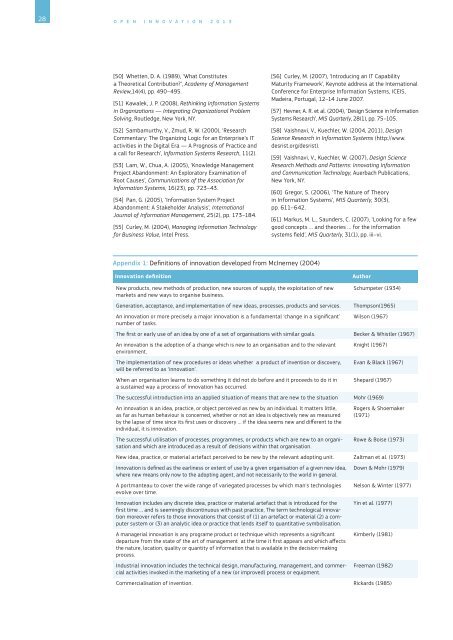Open Innovation 2.0 Yearbook 2013 - European Commission - Europa
Open Innovation 2.0 Yearbook 2013 - European Commission - Europa
Open Innovation 2.0 Yearbook 2013 - European Commission - Europa
You also want an ePaper? Increase the reach of your titles
YUMPU automatically turns print PDFs into web optimized ePapers that Google loves.
28 O P E N I N N O V A T I O N 2 0 1 3<br />
[50] Whetten, D. A. (1989), ‘What Constitutes<br />
a Theoretical Contribution?’, Academy of Management<br />
Review,14(4), pp. 490–495.<br />
[51] Kawalek, J. P. (2008), Rethinking Information Systems<br />
in Organizations — Integrating Organizational Problem<br />
Solving, Routledge, New York, NY.<br />
[52] Sambamurthy, V., Zmud, R. W. (2000), ‘Research<br />
Commentary: The Organizing Logic for an Enterprise’s IT<br />
activities in the Digital Era — A Prognosis of Practice and<br />
a call for Research’, Information Systems Research, 11(2).<br />
[53] Lam, W., Chua, A. (2005), ‘Knowledge Management<br />
Project Abandonment: An Exploratory Examination of<br />
Root Causes’, Communications of the Association for<br />
Information Systems, 16(23), pp. 723–43.<br />
[54] Pan, G. (2005), ‘Information System Project<br />
Abandonment: A Stakeholder Analysis’, International<br />
Journal of Information Management, 25(2), pp. 173–184.<br />
[55] Curley, M. (2004), Managing Information Technology<br />
for Business Value, Intel Press.<br />
Appendix 1: Definitions of innovation developed from McInerney (2004)<br />
[56] Curley, M. (2007), ‘Introducing an IT Capability<br />
Maturity Framework’, Keynote address at the International<br />
Conference for Enterprise Information Systems, ICEIS,<br />
Madeira, Portugal, 12–14 June 2007.<br />
[57] Hevner, A. R. et al. (2004), ‘Design Science in Information<br />
Systems Research’, MIS Quarterly, 28(1), pp. 75–105.<br />
[58] Vaishnavi, V., Kuechler, W. (2004, 2011), Design<br />
Science Research in Information Systems (http://www.<br />
desrist.org/desrist).<br />
[59] Vaishnavi, V., Kuechler, W. (2007), Design Science<br />
Research Methods and Patterns: Innovating Information<br />
and Communication Technology, Auerbach Publications,<br />
New York, NY.<br />
[60] Gregor, S. (2006), ‘The Nature of Theory<br />
in Information Systems’, MIS Quarterly, 30(3),<br />
pp. 611–642.<br />
[61] Markus, M. L., Saunders, C. (2007), ‘Looking for a few<br />
good concepts … and theories … for the information<br />
systems field’, MIS Quarterly, 31(1), pp. iii–vi.<br />
<strong>Innovation</strong> definition Author<br />
New products, new methods of production, new sources of supply, the exploitation of new<br />
markets and new ways to organise business.<br />
Schumpeter (1934)<br />
Generation, acceptance, and implementation of new ideas, processes, products and services. Thompson(1965)<br />
An innovation or more precisely a major innovation is a fundamental ‘change in a significant’<br />
number of tasks.<br />
Wilson (1967)<br />
The first or early use of an idea by one of a set of organisations with similar goals. Becker & Whistler (1967)<br />
An innovation is the adoption of a change which is new to an organisation and to the relevant<br />
environment.<br />
The implementation of new procedures or ideas whether a product of invention or discovery,<br />
will be referred to as ‘innovation’.<br />
When an organisation learns to do something it did not do before and it proceeds to do it in<br />
a sustained way a process of innovation has occurred.<br />
Knight (1967)<br />
Evan & Black (1967)<br />
Shepard (1967)<br />
The successful introduction into an applied situation of means that are new to the situation Mohr (1969)<br />
An innovation is an idea, practice, or object perceived as new by an individual. It matters little,<br />
as far as human behaviour is concerned, whether or not an idea is objectively new as measured<br />
by the lapse of time since its first uses or discovery … if the idea seems new and different to the<br />
individual, it is innovation.<br />
The successful utilisation of processes, programmes, or products which are new to an organisation<br />
and which are introduced as a result of decisions within that organisation.<br />
Rogers & Shoemaker<br />
(1971)<br />
Rowe & Boise (1973)<br />
New idea, practice, or material artefact perceived to be new by the relevant adopting unit. Zaltman et al. (1973)<br />
<strong>Innovation</strong> is defined as the earliness or extent of use by a given organisation of a given new idea,<br />
where new means only now to the adopting agent, and not necessarily to the world in general.<br />
A portmanteau to cover the wide range of variegated processes by which man's technologies<br />
evolve over time.<br />
<strong>Innovation</strong> includes any discrete idea, practice or material artefact that is introduced for the<br />
first time ... and is seemingly discontinuous with past practice, The term technological innovation<br />
moreover refers to those innovations that consist of (1) an artefact or material (2) a computer<br />
system or (3) an analytic idea or practice that lends itself to quantitative symbolisation.<br />
A managerial innovation is any programe product or technique which represents a significant<br />
departure from the state of the art of management at the time it first appears and which affects<br />
the nature, location, quality or quantity of information that is available in the decision-making<br />
process.<br />
Industrial innovation includes the technical design, manufacturing, management, and commercial<br />
activities invoked in the marketing of a new (or improved) process or equipment.<br />
Down & Mohr (1979)<br />
Nelson & Winter (1977)<br />
Yin et al. (1977)<br />
Kimberly (1981)<br />
Freeman (1982)<br />
Commercialisation of invention. Rickards (1985)
















